What is one of the first things you notice as you drive by a dairy farm? Some might say the smell, but for even those outside of the industry, one of the first things you notice are the barns. They are the farm.
On most modern freestall barns, especially those in cold, snowy or windy environments, a curtain system will outline each building. Curtains are the walls and windows, representing much of the building’s presence. The curtain system can set the tone for how the structure is perceived but also, more importantly, for how well it functions.
When you see a barn outfitted with ripped, dirty fabric, unevenly fixed to the sidewall with broken cable or strapping, you may think to yourself, “If the outside looks like that, how bad is the inside?” Now, for the dairyman, barn aesthetics may not be top priority; however, cow comfort, sustainability and profitability are of concern.
He knows a curtain system in that condition isn’t serving its purpose of regulating temperature and maintaining air quality. The curtain system is not a feature the importance of which should be dismissed based on finding the cheapest or most familiar option. So how do you decide what is best for your farm?
When it comes to making a decision on a major structural/functional element of a barn, you need to know what your options are so you can make an informed choice. It can help to think through some questions during the planning process in order to assess the type of curtain system you need. The answers you give to the following questions can send you in the right direction.
- What are the challenges with the current system?
- Are animals dealing with respiratory issues?
- Is plastic ripping due to high wind, bedding or animal interference?
- Is bedding being wasted or stalls unused due to wet or uneven bedding?
- What is the air quality in the barn? Does it smell stale or like ammonia?
- Are curtains open/closed when they shouldn’t be?
- Will there be designated staff to monitor air quality and temperature to operate the curtains?
- How much time and money has been invested in maintaining the current system?
When you stop and ask these questions, walk through the facility and be sure to talk with the staff as well. It’s easy to overlook an issue when focused on something else or when you aren’t involved in the day-to-day operations.
There are a few things to remember when reviewing options for curtain systems. For barns with large sidewall openings, especially those in cold-weather climates that require winter ventilation, a double curtain will provide the most flexibility and tailored functionality (Photo 1).

During the winter, you want to ensure proper air exchange, and a top-drop curtain does that by allowing fresh air to enter the barn at the highest point of the curtain above the cows, forcing stale/warm air up and through the roof (Photo 2).
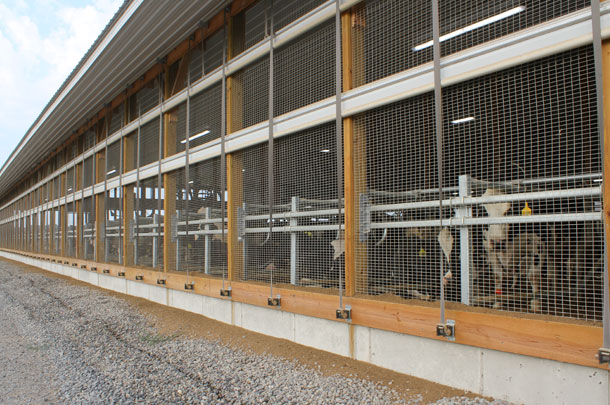
Have an understanding of how your barns are positioned and how wind direction plays into ventilating a specific facility.
Adding rain sensors along with temperature sensors may be necessary in locations where rain blows in from a certain direction and only one side may need to be closed. Consider bedding-saving curtains that contain a bottom curtain which can close if it’s raining or windy while keeping the top portion open for air exchange and temperature regulation.
A double roll-up curtain is also good if you have a lower knee wall.
Outfitting your curtain systems with bird wire or other wire paneling can also help keep curtains in place while providing a barrier for birds entering the barn and from cows licking or chewing on curtain material (Photo 3).
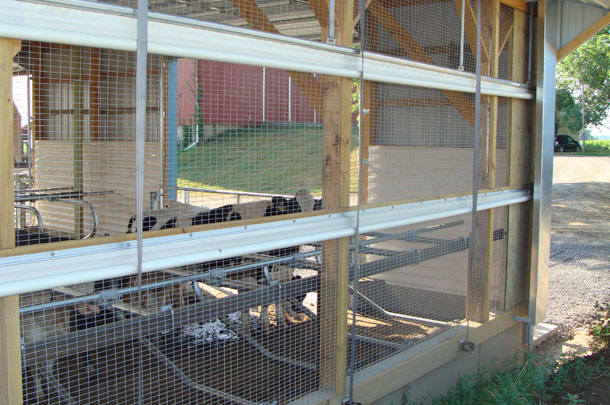
Another thing to consider is using pipes to retain the curtain systems as opposed to the common nylon strapping (Photo 4). A pipe system is easier to install, as it involves less hardware and doesn’t stretch or fray over time. This is a good way to go for a barn located in an area with very high winds.
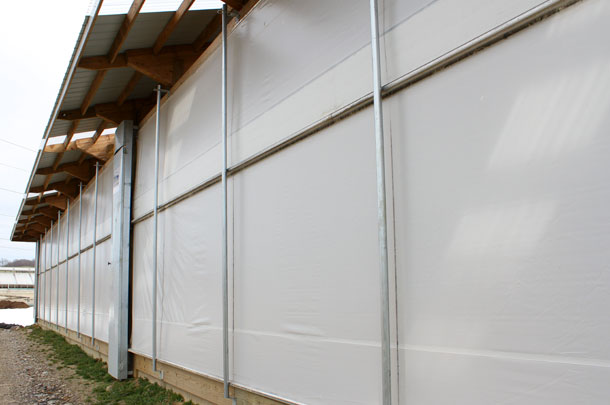
Don’t forget about choosing proper curtains for alleys and transition walkways as well. You will want these areas open in warmer weather and closed during the winter, so they need to be included when you plan your system.
Other areas where curtains can be used are between the parlor and holding area to separate the two (Photo 5), as well as coverings for ridge vents (Photo 6) and gables (Photo 7).
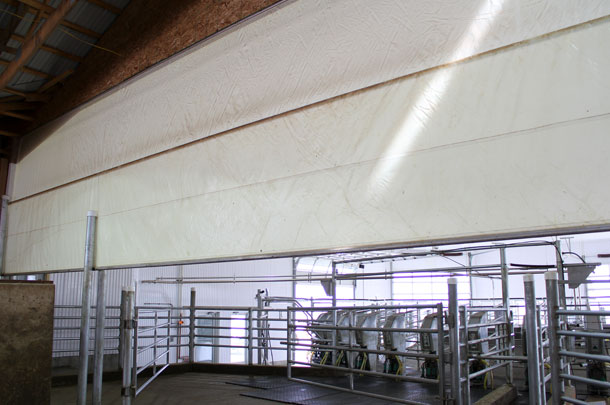
If you live in a location where weather is constantly changing, you should consider the level of automation you want to implement. Let’s face it, if there is a 20-plus- degree temperature difference between sunrise and sunset, a thunderstorm and high winds, you aren’t going to be adjusting your curtains every couple of hours.
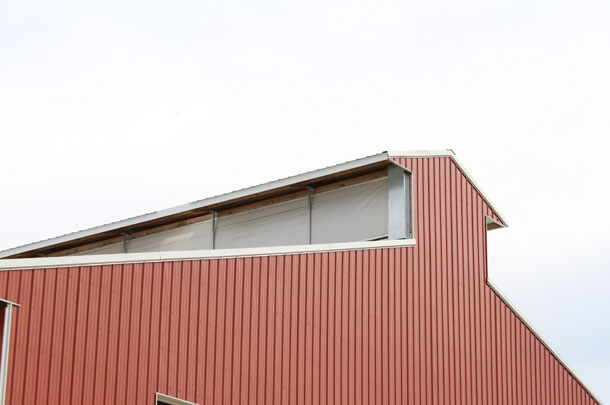
You need automation; your cows need automation. Technology is progressing when it comes to automation options, and there really is no reason for anyone to be hand-cranking a curtain anymore.
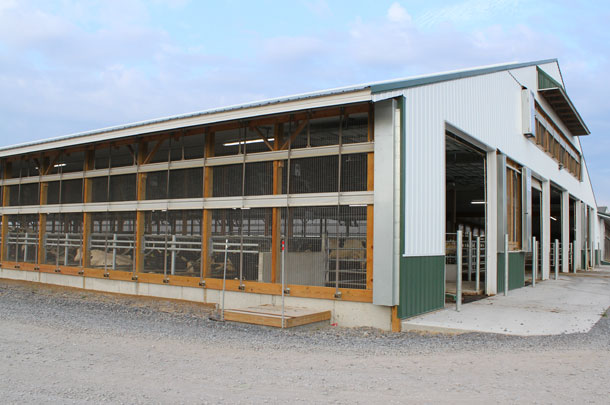
When you think about the impact proper temperature and clean air have on a dairy cow’s health and milk production, it isn’t worth it to leave it up to chance. Take the help where you can get it, especially when it comes to cow comfort. It has been proven time and time again; comfortable, happy cows make more milk.
A curtain automation system is an investment that can pay for itself in a short period of time when you break it down by man-hour savings and potential loss of production. There are simple temperature- and rain-sensing options that can operate curtains based on temperatures and conditions inside and outside the barn.
Many automated controllers also offer wind speed and direction monitoring as well and will automatically open or close your curtains based on the collective weather conditions. As with anything, there is an initial investment to be made with these options, but they are well worth it in the end.
When making your final decisions, keep in mind some of the following questions, as they can make a difference in how much time and money you invest in maintenance in the future.
- How long is each section? Are there enough motors to operate each section easily and not burn out?
- What materials are being used? Are they easy to install and replace if necessary?
- What type of service is available if my curtain system has issues?
- Can my automation easily be updated as new technology is released?
Curtains are a huge part of a barn’s functionality and the success of the animals residing there. As a busy dairy farmer, you try to make the best decisions for your business to be profitable in the future.
When it comes to such an important feature that directly affects cow comfort, it is critical to make informed decisions and align yourself with contractors and suppliers who have your best interests in mind. Not only will you get a properly functioning and well-ventilated barn, it can be a showpiece of which you will be proud. ![]()
PHOTOS: Curtains not only complete the look of a dairy barn, but they also serve important functions in providing a comfortable, well-ventilated facility for cows. Photos provided by Seneca Dairy Systems.
Victoria Diegnan worked for Seneca Dairy Systems at the time this article was written.





